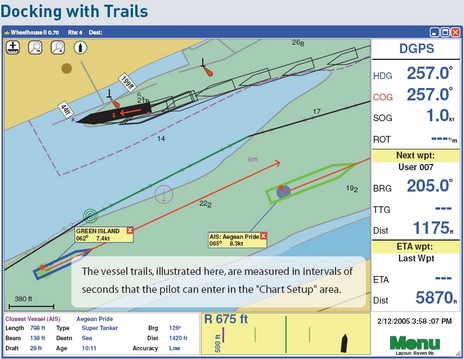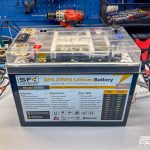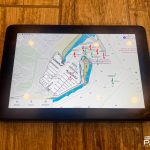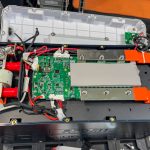AIS Class B worries, a rebbutal

My recent mention of Class B negativity elicited a lot of interesting comments, including a long post by Mr. Fred Pot himself. Fred, who I once profiled as “AIS man”, has now established himself as the Class B curmudgeon, not just the inspiration of Navagear’s “AIS Class B Naysayers, Unite!” but also a rather negative Class B sidebar to an otherwise enthusiastic AIS article by Steve Dashew in the current issue of PassageMaker. I count Fred as an industry friend, but I think he’s gone way overboard on this subject, as shown by a couple of points made in yesterday’s comment:
* Fred claims that “About 70% of commercial ships piloted into US harbors do not have a radar or an ECDIS (or ECS) that can show AIS targets on screen,” i.e. they’re not really monitoring AIS targets. Apparently he got that figure from “two pilots” at a conference, which means it’s hearsay, but is especially ironic as the figure ignores the fact that it’s the pilots who very often bring excellent AIS plotting to a ship’s bridge when it’s in challenging situations. I saw that big time last summer when I got to know Skip Strong, who pilots ships up and down my local Penobscot Bay. Now I’m confident that every ship I see out there is piloted by a conscientious professional equipped with a powerful AIS plotting tool, namely the Wheelhouse II software seen above. I think the same is true in many bays and harbors.
* Fred also figures that big ships will “un-clutter navigation displays by filtering out less important {Class B} targets.” Well, for starters, this worry doesn’t make sense with the one above. If the ships are not looking at AIS displays, then why the heck would they filter them? Plus, it seems to ignore the reality of which vessels will actually be using Class B transponders. I believe the Coast Guard still intends to expand mandated AIS, Class B allowed, to some 17,400 vessels. Here in Penobscot Bay and many other places, these are the big cross-bay ferries and ocean-going fishing boats that the ships (and pilots) really do want to know about.
Plus this worry predicates a cluttered screen, when in fact my experience is that the most dangerous ship encounters are offshore where the screens are uncluttered, but everyone’s relaxed and moving right along. I asked the gCaptain to survey his ship-running readers on this general subject and all seemed to agree that even if they had to filter out small targets in busy places they’d pay attention to everything outside the sea buoy. It was good to hear that, but not really surprising. While there are fools driving ships just like there are fools driving yachts, I think most mariners of either sort are trying to take in and integrate as much information as possible and avoid mishaps of any kind. Thus, despite what the good Captain Rodriquez suggests, I don’t think AIS “provides too much information.” For me, the more info the better means that if a Class B transponder only costs a few hundred dollars more than a good receiver, that’s the way to go. Sorry, Fred!













Ben,
As a professional mariner for the past thirty years, I believe AIS is the greatest addition to maritime safety since radar. If the introduction of low cost Class B AIS systems encourage yachters to install them, it will make our jobs easier and save lives.
I completely agree with you that the most dangerous encounters occur offshore. We all know there have been too many incidents of yachts being run down by ships and it’s usually the yacht operator’s fault.
Fred Pot’s hearsay is probably correct, but what’s the point. Several years ago, a recently retired friend at the UKHO told me that worldwide less than 1/2 of a percent of commercial vessels were using dual ECDIS systems. Nevertheless, more and more commercial vessels are using an ECS that can display AIS targets on the screen. Besides, prudent mariners use every tool available.
While I’ve never been involved in a near collision with a ship; the same isn’t true with yachts. Many of these boats are operated by people with limited skills, and yachts are much more difficult to detect offshore on radar, particulary if they do not have a radar reflector. Now, if yachters will purchase a Class B AIS AND a copy of the Navigation Rules and learn them, we’ll all be safer and happier.
I think I can speak for my fellow professional mariners when I say that any tool that enhances safety at sea is welcome.
Jean
Ok – I was wrong. Maybe for the first time today. Thanks Ben.
It’s obvious that AIS has enormous CA potential and that will be fabulous. But until it is more universal, settled in and widespread in it’s use, it is both an upside and a downside. It can create a false sense of security because mariners have more information. But it also can be BLIND to those without transponder units and this becomes almost an INCREASED risk/hazard.
It’s no dif then relying on radar and not seeing a vessel with no radar return. You think the coast is clear and BOOM. But radar IS a valuable asset and it adds to the information a mariner has.
More information used PROPERLY, the better off we all are.
It will get better.
Righto, Def; not carrying Class B because it’s not perfect is comparable to not carrying radar for the same reason. And if a boater is inexperienced and unaware enough, he can work up a false sense of security with just a road map and a faulty echo sounder…at least for a while.
I’m with you that there’s no such thing as too much nav information, as long as it’s used properly. However, if I did what Capt. Rodriquez does–i.e. help boaters out of jams all day–I might be more skeptical about their general ability to handle complexity!
Truely great discussion about AIS–and our questions about “B”. After reading this, I would opt for a class “A” unit. Not that B will not be seen or recognized, but that if you want to be “seen”; the most information, is important.
What is often missed is that although most US professional mariners are good at standing watch and having adequate crew on the bridge, this is not true on all ships. We have lost several friends where the the large ship’s watch keepers were not alert and the pleasure vessel was run down, even though they were taking evasive action.
In our several hundred thousand miles at sea in recreational vessels up to 62 feet, we have had a few near misses. They were due to lack of attention of watch standers on commercial vessels often in areas of limited visability. There were several times when at night we could not raise anyone on the bridge, when we wanted to arrange appropiate crossings. (Ie: “should I take your bow or stern?”) In one case we finally put a searchlight right on the bridge of a 600 foot freighter–it apparently woke up the mate, because he put the ship into full reverse and flipped on all lights. This did not resolve the situation, so we just turned on our engine, and powered 180 degrees away from the ship, directly into the trades. Five minutes later the VHF came alive–“the sailboat on our Starboard beam, this is the Captain of XXXX bound from XXX to XXX. The first mate was alone on the bridge and was asleep. I appologize and assure you that he will be leaving the ship at XXXX.” There were other situations where background lights and a sharp bend in the track (comming into Straits of Messina) we and a 150 foot coastal freighter occupied the same stretch of water–both of the vessels had two persons on the bridge, with radar and had not recognized the other vessel as we turned a blind corner. We both reacted by turning rapidly to stb, so collision was averted.
In another case two Liberian Vessels intentionally came as close as they could to us, with out hitting, despite my attemted contact on VHF. In all of these cases an AIS would have clarified what was there and what course we should have taken. An alarm for CPA on the AIS would be a real plus–if it is used to alert the crew!
I also discussed the AIS with a friend who is the skipper of a large tug, and he basically ignores it in port. There are too many visual issues which he has to deal with, as described in the above articles.
Mr. Pot is correct in his statement that the majority of merchant vessels do not have a radar, ECS or ECDIS array that displays AIS targets. AIS capable radars aren’t even mandated until 2008 for new installations. The mariner most frequently relies on the MKD display on a typical AIS A installation. Pilots who use portable laptop units have the AIS display capability, for a very good reason….it’s not available on the ship. It will be there eventually.
An email comment from writer/boater John Kettlewell (http://kettlewellcruising.blogspot.com/)
I’ve noted some discussions on your site with regard to the usefulness of AIS for yachts. While I have no direct experience of AIS, I do take exception to the comment from one of your readers that “it’s usually the yacht operator’s fault” when commercial vessels and yachts come too close or are involved in accidents. Yes, some yacht captains do operate recklessly, but I have more than 30 years of offshore experience and I can recall numerous times when commercial vessels were operated without regard to the Rules of the Road. Our basic rule is to avoid any encounters if at all possible, but even well offshore we have had numerous close brushes with ships approaching on collision courses that do not take any action to avoid a collision. In many of these cases we were unable to contact the bridge using VHF radio. In every case we were showing proper running lights at night, and in many instances visibility was very good. And, smaller commercial craft in parts of the Caribbean often show no nav lights or improper lights, ignore all rules, and seemingly run on autopilot with no one on the bridge. I can vividly recall a night where we nearly ran into the tow cable for a huge water barge that was completely unlit and being towed well behind a huge tug off of Nassau in the Bahamas. In general, commercial craft along the shores of the U.S. and Canada are professionally operated, but away from the coast and in other parts of the world all bets are off. I suspect AIS will simply be ignored by those who aren’t currently operating safely, and AIS will be utilized by those already observing and reacting properly to small craft so I’m not sure the overall improvement in safety will be very noticeable.
I had rtead in some professional publication (?maybe Digital Ship?) that ships in the Channel were filtering-out Class “A” signals from vessels under “X” in length. Of course, this presumes that bridge personnel know how to program their AIS equipment!
There is a shortage of feedback from Class B users in the US for obvious reasons, but there isn’t much feedback from anywhere else either. Do users feel that AIS is worthwhile or not? Everybody does in theory, but in real life, is it a “don’t leave home without it”, or is it a nice toy, or is it somewhere in between?
For boaters, the main point is collision avoidance. Bureaucrats may have other agendas, but for us it comes down to wanting to see and be seen.
On the “see” side, there is nothing at all wrong with Class B. The equation is AIS receiver = Class B = Class A. It doesn’t matter which I have, they all show the same info. There’s just a difference in price. They may differ in how they display the info though. It could be shown on your radar, on your chartplotter, or on an MKD.
For Class A, the IMO says you have to have at least a MKD (minimum keyboard and display) which shows at least three lines of text, showing bearing, range, and ship name. It seems this was never intended to be anything more than a backup display, but that is not how it worked out. See:
“AIS Implementation – Success or Failure?” by Andy Norris, in The Journal of Navigation, Jan 2007:
http://tinyurl.com/2zjdmj
Which brings us to the “be seen” side. Here the equation is Class A > Class B > AIS receiver. In theory. But you can’t assume anything about any particular ship. Not that they have anything more than an MKD display, not that they are looking at it, not that they even know how to use it. Don’t throw away that radar reflector just yet.
And smaller boats where AIS is not mandatory probably don’t have it, and are probably less likely to use it properly if they did.
Norse – I would think very carefully about having any faith in radar reflectors unless you have read the UK MAIB report into the loss of the yacht “Ouzo”.
http://www.maib.gov.uk/publications/investigation_reports/2007/ouzo.cfm
This extensive report investigates not only the loss of the vessel but also a thorough, scientific testing and appraisal of radar reflectors and the probability/possibility of a small boat being seen on a ship’s radar (Annexes to the report).
Prepare to be shocked.
AIS has to be better than a bit of bent metal hanging from the mast.
I sail like I drive – don’t trust anyone and stay out of the way of the big boys.
Roger is right about defensive driving. The Ouzo investigation showed that their radar reflector was inadequate, but it also showed that a good one would have prevented the accident. Good ones are big and expensive and hard to find. The investigation said that AIS would not have helped because the ship did not display that info on its radar. However, I think it would have helped because the yacht could have called the ship on the VHF and because it would be more obvious that the ship was changing course.
Here is a summary of another article on this theme that I want to comment on. “Big boats overlook small ones – AIS gives false assurance” http://www.fiskaren.no/incoming/article154269.ece (in Norwegian) 24 Dec 2007 :
After several tragic collisions between fishing boats and larger ships, one Norwegian fisherman who fishes in a high traffic area decided to install an AIS system so that he could see and be seen. He fished, confident that his boat would appear on the ships’ chartplotters.
One day he called up a ferry and talked with the skipper. By chance he asked if he could be seen on the ferry’s chartplotter. Not at all. Chills ran up his spine. Same thing when he contacted other large ships. He had lived under the illusion that his investment would increase his security. He advised other fishermen that investing in AIS without making basic checks was a waste.
The explanation he found later was simple but serious and scandalous. There are two types of AIS in the market, class A (required for big ships) and class B (recommended for fishing boats). But the signals from Class B are in some way filtered out by the big ship’s chartplotters — they only see a line of text on a little display.
He checked that with a series of large ships with Class A AIS and that was confirmed time after time. He doesn’t like it that they sell systems which give false security.
Instruments on board are only to help, but they must function in order to help. The two types of AIS must communciate with each other
He obviously put too much faith in others and in equipment.
The fisherman assumes Class A would have been better. Would it really have made much difference? What percentage of ships just have AIS in some out of the way location, never looked at?
The fisherman assumes that Class B is filtered out from the ship’s displays. That claim gets made, but is it true? I’m looking for manuals for Class A AIS which tell about this “feature”. The Furuno AIS unit does not seem to have this feature. That AIS just sends the data to their radar or chartplotter displays, and those could easily filter it, in theory. But do they really have a “don’t show Class B” feature?
I would argue that having (a truly capable) radar reflector is more important than AIS, and AIS should compliment it rather than be an either/or choice.
For one thing … without a radar reflector, me or 1,000 other boats in my harbor might be more likely to hit you with with our sail or powerboats. Yea, we are small, but it could still be life threatening. Although I will be an early adopter, less than half of my fellow boaters with radar will have AIS 5 years from now.
Secondly, I had an interesting chat with the captain of the Noregian Gem Cruise Ship about AIS this past week, on his brand new cruise ship. He expressed that it was more important to show up on his radar as a radar contact than an AIS contact alone, certainly showing up as both is ideal. I didn’t entirely understand his point as much as I tried (English is not his native language), but it seems he and his navigators have found all to often that small boats are miss-reporting their positions since they started sailing on the GEM two months ago in Europe. They explained they get green triangle AIS indicators on their displays where no boat exists. After experiecing this repeatedly, there seems a potential that targets will be ignored if there is no radar blip underneath the AIS triangle.
I also found it interesting that he took the view that AIS integrated with radar reduces the information he has at hand when they encounter a crossing condition with an AIS contact, compared to the container ship he last commanded that had AIS contacts in text. He explained that in his previous command he had instant access to lots of information on other ships via a dedicated display, where as now, they have to move a cursor over each contact to get the detailed information (such as rate of turn), which becomes inefficient in a crowded waterway. While his radar did have an option to display text next to each AIS contact, they couldn’t use that feature as it clutters the display. As the density of ships increases, they need to instead focus on standard watch keeping techniques without the aid of AIS. Hard to tell if this is a common problem, or if he was just overly making his point that “plastic boats” need to make themselves more visable on radar.
The MAIB report on he loss of Ouzo and the efficiency (or otherwise) of radar reflectors showed that the most effective method for a small plastic boat to show a big splash on a radar screen is the “SeaMe” or similar active radar transponders.
Only works with X-band unfortunately.
If you really worry about being seen, an expensive, passive reflector and an active transponder and a Class A AIS should work.
But is there someone on the bridge looking at these displays or are they too busy composing an SMS to the girl-friend?
This from a MAIB marine accident report.
The 2/O was distracted for over 40
minutes prior to the grounding, so he
missed the alteration of course required
by the navigational plan. By
concentrating on text messaging using
his mobile telephone, he had no capacity
to monitor his vessel’s passage, and he
was oblivious to her progress. The
OOW’s principal responsibility is to
ensure the safety of the ship – and
nothing should distract him from this.
Hello Ben,
I was looking at the FA 150 Class A unit Brochure from Furuno and got to thinking about something. It lists the transmit frequency as ranging from 2s to 3min depending on speed and course alternation. Can you find out from someone what the transmit rate is for a yacht going 8 knots in a straight line. I am wondering if it is as much more frequent than Class B at yacht speeds near 8 knots compared to ship speeds which usually range from 16 to 22 knots. Might take away one of the Class A advantages should class B ever actually get approved.
Hi Gram. A ship going straight at 0-14 knots transmits dynamic Class A AIS data every 10 seconds, which is still three times faster than Class B at any speed. If said ship starts turning, the rate goes to a little over 3 seconds. Straight at 14-23 knots means a transmission every 6 seconds, then ever 2 seconds if you turn (or go faster).
Yacht’s the size of Visions (http://tinyurl.com/23f47w) are installing Class A units, but mind the power requirements.